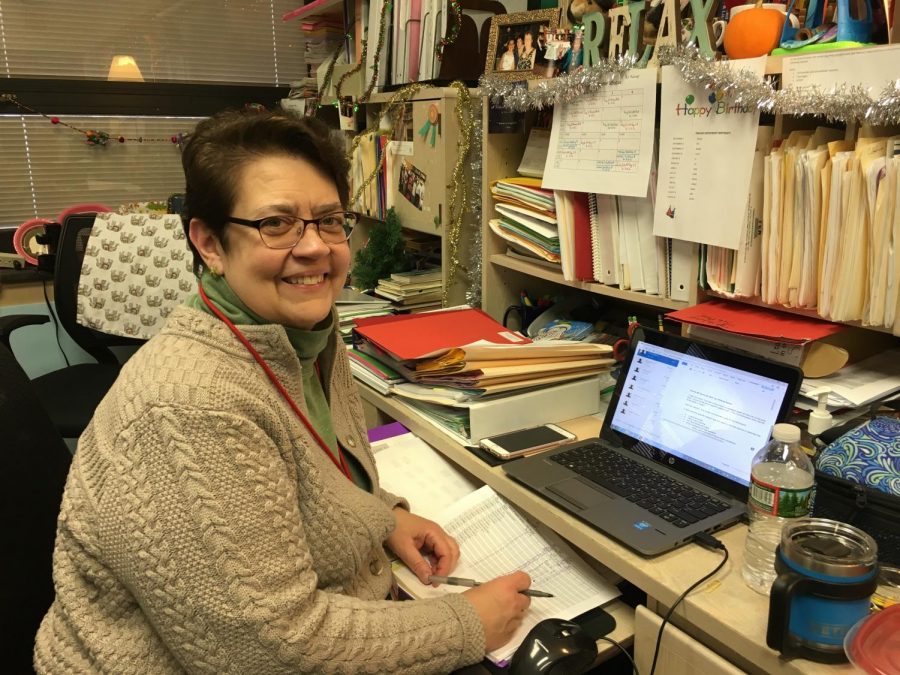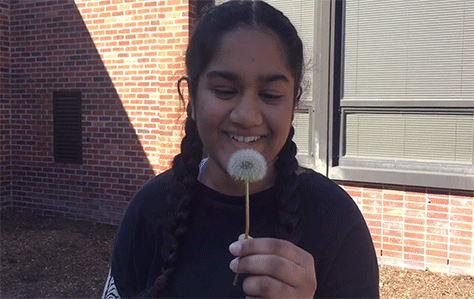Thought she was just a teacher? Psych
Photo Credit: Githmie Goonatilleke
Ms. Pat Mahoney spends the majority of her week as an English teacher, grading tests, teaching literature and helping her students. But on the weekends, Mahoney helps people in a different way: as a psychoanalyst.
January 11, 2018
Pat Mahoney leads a double life.
Monday through Friday she helps her students understand great works of literature and the symbols behind them. But when the weekend begins, she helps people in a different way: as a psychoanalyst.
A psychoanalyst is a type of therapist who looks at the unconscious motivations of people’s behaviors and helps those people release blocks that get in the way of their daily lives.
“You’re helping people to improve their lives, but you’re trying to help them get at the deeper levels of their behaviors. Why they do the things they do,” Mahoney said.
Mahoney started teaching English right out of college, in 1982, with her first job at Oak Knoll School of the Holy Child. It wasn’t until 1989 that she started teaching in Glen Rock.
“I think I always wanted to be a teacher. I think it was something I knew since I was a kid,” she said. Mahoney credits two of her own high school English teachers as role models and influences that gave her the push to become a teacher.
But somewhere along the line she also developed an interest in psychoanalysis.
Mahoney fulfilled her interests for a while by taking classes occasionally. However, as time went on she became more and more interested in the subject and started taking three classes at a time.
To become a psychoanalyst, Mahoney had to go through years of training and clinical fieldwork, all while simultaneously teaching full time. The whole process took 10 years and she received her certification in 2001.
When she first started her fieldwork, Mahoney worked at a state hospital where would see “severely regressed patients.” She later worked at a mental health clinic and took on walk-in patients of any age and mental state.
Mahoney also had to complete a fieldwork internship which she did at Greystone State Psychiatric Hospital. Most of the hospital has since been closed down and Mahoney described the asylum as “your horror image of a psychiatric hospital.”
This internship was followed by an additional three-year internship at a community mental health center run by the psychoanalytic institute where she was training. Psychoanalysts-in-training have to complete hundreds of hours of work with patients both in a hospital and in a clinic setting.
This clinical part of the training is in addition to coursework in the theory, history, and clinical practice of psychoanalysis. At the end of the coursework, analysts-in-training write a dissertation, an individual case study on a research question from the analyst’s work with one patient over the course of at least two years.
Now that she’s completed her training, every Saturday and Sunday morning Mahoney makes the drive to her own office in West Orange to see her patients.
Working weekdays at school and weekends at her office means Ms. Mahoney is constantly busy. There was even a time where Mahoney would work Friday nights, leaving the high school each afternoon and driving straight to her office.
“She does so much,” senior Luke Blomstrom said, “Already she’s a teacher, which takes a ton of time, and then she has an entire second job. Then she also runs Mobius, which is super involved. It’s amazing how much stuff she does and how good she is at it.”
Blomstrom first met Mahoney in the second semester of his freshman year when he took Writers Workshop. He also joined Mobius shortly afterwards because he knew Mahoney was the adviser.
Whether Mahoney is teacher or adviser to him, Blomstrom describes each environment she leads as a positive one.
“I was never going to be somebody who was removed from my students. I was always going to be engaged in a journey with my students,” Mahoney said.
The connection that Mahoney has with her students is one she shares with her patients as well and believes that the way she is as a teacher is the way she is as a therapist.
“You’re working with people, you’re helping people. You teach literature, you’re looking at symbols, what does this mean? You are looking at characters’ stories,” Mahoney said, “You study a person’s life, and you’re doing the same thing; what do events in a person’s life mean? You’re helping people make sense out of their lives.”





Ms. Pat Mahoney • Jan 20, 2018 at 7:46 pm
Thank you, Githmie, for such an in-depth feature story! I appreciate your attention to detail in this article. We talked for a long time, and you did a wonderful job of capturing the essence of what I was describing about my journey in two different but related professional worlds. Thank you!